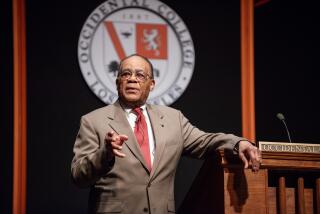Clifford Shull; Co-Winner of Nobel Prize in Physics
- Share via
Clifford G. Shull, who earned a Nobel Prize in physics almost half a century after he began his pioneering work in neutron scattering, which opened up a new area of research, has died. He was 85.
Shull, who shared the 1994 Nobel with Canadian professor Bertram Brockhouse, died Saturday in Medford, Mass.
Working independently, the two scientists discovered neutron scattering techniques that can analyze matter--akin to ricocheting bullets revealing the location of obstacles in the dark--when X-rays and microscopes fail to reveal enough detail.
“In simple terms,” the Royal Swedish Academy of Sciences said in announcing the Nobel seven years ago, “Clifford G. Shull has helped answer the question of where atoms ‘are’ and Bertram Brockhouse the question of what atoms ‘do.’ ”
Among the elements that Shull’s research in neutron scattering exposed to close examination was hydrogen, which had resisted older methods of analysis.
The revolutionary research tool led to construction of high-tech ceramic superconductors and detailed study of the structure of viruses, which can improve medical treatment for many illnesses.
Born Clifford Glenwood Shull in Pittsburgh in 1915, the youth intended to become an aeronautical engineer, but was inspired by a high school teacher to go into physics.
After graduating from the Carnegie Institute of Technology (now Carnegie Mellon University) and earning a doctorate at New York University, where he engaged in nuclear physics research, Shull took a research job at the Texas Co. (later Texaco) in Beacon, N.Y., in 1941.
As the U.S. moved into World War II, he wanted to join the Manhattan Project to develop the nuclear bomb. But when the invitation came, Texaco refused to release him, saying his ongoing research in developing high-performance aviation fuel was far too valuable to the war effort.
So it was 1946, after the atomic bomb had been developed and detonated, ending the war, that Shull left the Texas Co. for Tennessee’s Oak Ridge National Laboratory, one of the Manhattan Project work sites.
With the laboratory shifting from military to civilian pursuits, Shull was assigned to work with physicist Ernest Wollan, to help investigate using the neutron beams produced by the nuclear reactor to analyze the structure of matter.
By studying simple compounds such as table salt, they discovered that neutrons are deflected in a distinctive pattern when they strike a sample of material. That allows researchers to determine the sample’s atomic structure.
Shull also initiated studies with neutron diffraction to investigate the properties of metals, including how they become magnetized. That research led to creating new magnetic materials for a wide range of products, from computer, audio and video components to refrigerator magnets.
Although Shull continued his work during his 1955-1986 tenure as physics professor at the Massachusetts Institute of Technology, Wollan died a decade before the Nobel was awarded.
Shull is survived by his wife, Martha-Nuel Summer; three sons, John, Robert and William; and five grandchildren.






